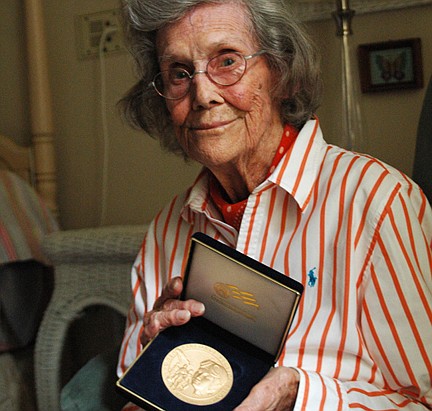- December 13, 2025
-
-
Loading

Loading

Being at the controls of a plane thousands of feet above the ground felt as safe as home for Patricia Chadwick Erickson.
For the men who were part of her crew, the experience wasn’t the same. She said they white-knuckled it all the way as she “rocked” her B-25 bomber from take-off to the landing. They weren’t ever sure a woman could do it safely — flying a plane was surely a man’s job.
“A lot of the men didn’t trust us,” Erickson said.
But they learned. Eventually they’d admit, surprised, that she was a good pilot after all. It was 1943, and Erickson was part of the second class of women to learn to fly military aircraft and be a part of the Women Airforce Service Pilots (WASP) during World War II. All the children in her family — two brothers and a sister — volunteered along with her.
Erickson, now a 92-year-old Winter Park resident, was one of 25,000 women to apply to be a WASP and one of the 1,074 to successfully complete the grueling program out of 1,879 candidates who were accepted. The WASP members were considered civilians then, and their role was to free up Air Force men for combat military roles. They’d ferry soldiers from military base to military base, test out new planes and engines, fly planes to get repairs and make sure previously broken planes were safe to fly again.
For more information about the Women Airforce Service Pilots program, visit www.waspmuseum.org
“They were guinea pigs,” Erickson’s daughter Ingrid Campbell said.
“We were experimental,” Erickson agreed.
In many ways, the WASP members were used as not only a way to fill up necessary jobs during war, but also as a propaganda tactic to shame men into joining themselves —- if women can and will do it, you better too, said Amelia Lyons, a University of Central Florida history professor who researches gender studies and women’s history. While they didn’t fly in combat, they were quite frequently flying in combat-like situations, especially while operating planes that could potentially stop working at any second.
“They did a lot of dangerous work … some things that male pilots refused to do,” Lyons said.
But Erickson was never afraid. She felt much more comfortable up in the air than she did socializing with the other pilots at first. The Texas town where the training took place was light years away from Houlton, Maine, the very small town she grew up in — she was homesick for the trees. And the rich socialite girls with much more life and flying experience intimidated her before they became her friends. But as soon as she was trained, she really felt like somebody. It was quite a daring thing for her to do in that time — not just to leave her small town but leave to fly airplanes.
“Heaven, it was just like heaven,” she said of flying. “I was light and ready to go, to do anything after that.”
“She said it was the best part of her life,” Campbell said. “It really opened up the world for mom.”
And she’s always been like that — an adventurer, a woman with a wild side, Campbell said. When Jacqueline Cochran, one of the most well-known aviators of that time and the director of WASP, met her at an air show in Maine, Erickson wasn’t afraid to say what she wanted — to fly.
Cochran sent her a telegram inviting her to visit her in New York City to talk about it. Erickson walked all the way from the airport to her apartment, full of determination and spirit. Cochran saw that spark and immediately asked her to join the WASP program. She was quite a fitting representative for what the WASP name now stands for to women in the military.
“She was on the edge of women’s liberation … The WASPs set the pace,” Campbell said. “It opened the door for women in aviation.”
“It did have a really huge effect. … they are the forerunners, the foremothers if you will,” Lyons said.
But it didn’t last long. The WASP program was abruptly disbanded in 1944 when World War II was drawing to a close. They had helped fill the men’s roles in the sky, but now their job was to give the work back to them.
On Friday, Nov. 9, at 10 a.m., the city of Winter Park will be present its Veterans Day Celebration. The event will be held at the Winter Park Community Center Ruby Ball Amphitheatre located at 721 W. New England Ave. For more information, please call 407-599-3428.
“They were commended for it during the war, but it was pretty clear that they needed to get out of that kind of labor and move into traditional roles as wives and mothers,” Lyons said.
Erickson did just that, though she did marry a man with just as much spirit and passion for flying as she had — he was an Air Force pilot. Campbell said she didn’t hear much from her mother about being a WASP over the years, but for many women, they let the idea of recognition go. Finally, in 1977, they were given veteran status with benefits after more than 30 years of being considered just civilians. And in 2010, the group of women received the Congressional Gold Medal to recognize their service.
Campbell speculated that it must have been difficult for her mother to go all those years without appreciation. Erickson said it’s just what she had to do for her country.
“I was doing my duty for the war,” she said.